The Video Streaming Software Market is currently characterized by intense competition and rapid evolution, driven by technological advancements and shifting consumer preferences. Major players such as Netflix (US), Amazon (US), and Disney (US) are at the forefront, each adopting distinct strategies to enhance their market positioning. Netflix (US) continues to focus on original content production, aiming to differentiate itself through exclusive offerings, while Amazon (US) leverages its Prime ecosystem to integrate streaming with e-commerce, thereby enhancing user engagement. Disney (US), on the other hand, capitalizes on its extensive library of intellectual properties, utilizing its brand strength to attract subscribers to Disney+. Collectively, these strategies contribute to a dynamic competitive environment, where innovation and content quality are paramount.
The market structure appears moderately fragmented, with a mix of established giants and emerging players. Key business tactics include localized content production and strategic partnerships, which are essential for catering to diverse regional audiences. For instance, companies are increasingly localizing their content to resonate with specific cultural contexts, thereby enhancing viewer engagement and loyalty. This localized approach, combined with supply chain optimization, allows these companies to respond swiftly to market demands and consumer trends, further solidifying their competitive positions.
In September 2025, Netflix (US) announced a partnership with a leading gaming company to develop interactive content that merges streaming with gaming experiences. This strategic move is indicative of Netflix's commitment to diversifying its content offerings and engaging a broader audience, particularly younger demographics who are increasingly drawn to interactive entertainment. By integrating gaming elements, Netflix aims to enhance viewer retention and attract new subscribers, thereby reinforcing its competitive edge in the market.
In August 2025, Amazon (US) expanded its Prime Video service by launching a new tier that includes live sports streaming, a move that could significantly enhance its value proposition. This strategic action not only broadens Amazon's content library but also positions it as a formidable competitor in the live sports streaming arena, which has been a critical driver of subscriber growth for many platforms. By offering exclusive sports content, Amazon seeks to attract sports enthusiasts and differentiate itself from competitors who may not have similar offerings.
In July 2025, Disney (US) unveiled plans to invest heavily in augmented reality (AR) experiences for its Disney+ platform, aiming to create immersive viewing experiences that go beyond traditional streaming. This initiative reflects Disney's forward-thinking approach to content delivery, as it seeks to leverage emerging technologies to enhance viewer engagement. By incorporating AR, Disney not only aims to captivate its existing audience but also to attract tech-savvy consumers who are looking for innovative entertainment options.
As of October 2025, the competitive landscape is increasingly shaped by trends such as digitalization, sustainability, and the integration of artificial intelligence (AI) in content delivery. Strategic alliances are becoming more prevalent, as companies recognize the value of collaboration in enhancing their technological capabilities and expanding their content offerings. Looking ahead, competitive differentiation is likely to evolve from traditional price-based strategies to a focus on innovation, technological advancements, and supply chain reliability. This shift underscores the importance of not only delivering quality content but also ensuring that the underlying technology and operational frameworks are robust and adaptable to changing market dynamics.


















Leave a Comment